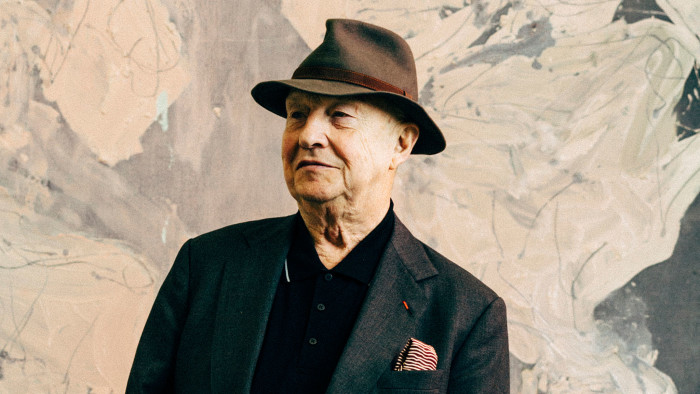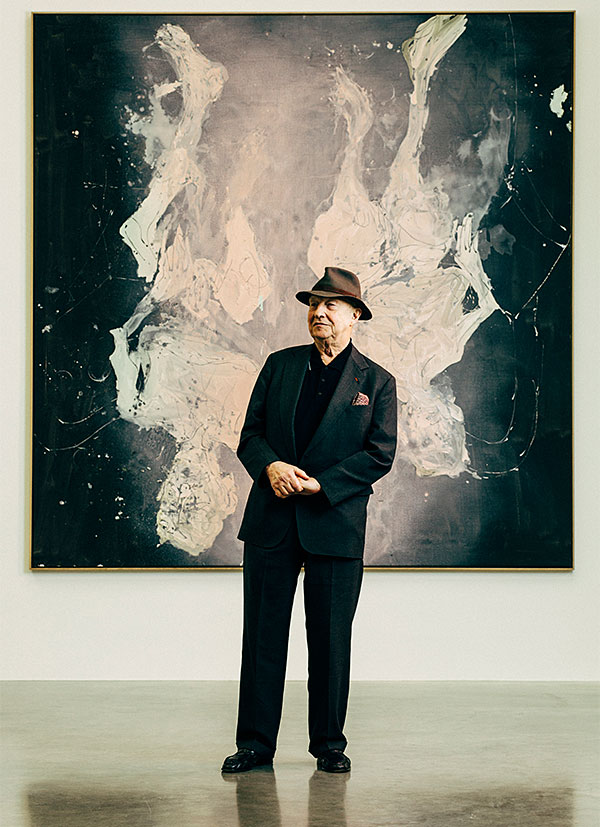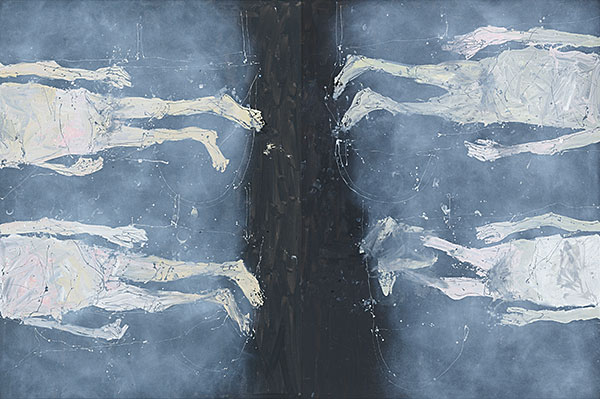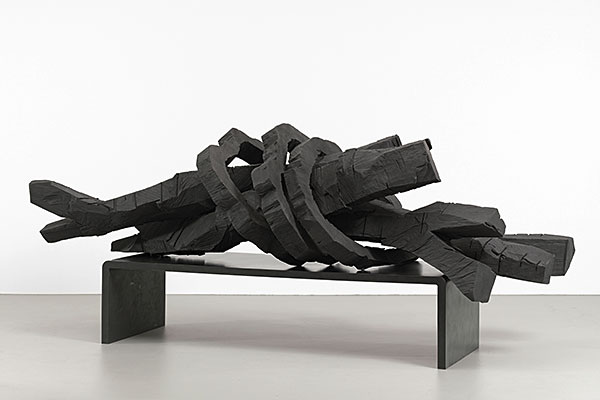The controversial German artist Georg Baselitz on his White Cube show

Simply sign up to the Life & Arts myFT Digest -- delivered directly to your inbox.
White Cube is peopled by giants. When I arrive, the gallery’s lofty owner Jay Jopling is contemplating “Zero Dom”, a three-metre black-matt patinated bronze of a bundle of legs in high heels, with its creator Georg Baselitz.
The artist, in grey suit and hat, is also towering: large, oval bald head, solid torso, gangly limbs. And representations of this huge body are everywhere: Baselitz’s latest paintings are nude self-portraits and double portraits with his wife Elke at monumental scale, the pair positioned upside down, side by side, so that their bodies hang down like bells — one six-metre canvas is called “Dystopische Glocken” — tolling mortality.
It is immediately apparent that these images build on the “Avignon” series of large-scale, vulnerable self-portraits launched at last year’s Arsenale exhibition in Venice. I tell Baselitz that for many viewers these were the highlight of the biennale.
His response is a snarl: “The context in Venice, where everything — a pearl, a sphere — had to be linked to the sociopolitical, is not something I’m interested in. Art as a whole has slid down into this fascist corner. This is the prism through which people see art now. I think it’s terrible. An artist shouldn’t involve himself in these experiments. In the GDR they said you had to use your talents only to support the worker. When I was driving here I saw a queue of homeless people in hoodies. If you take that on board as an artist, you’re lost.”
Born in 1938 in Saxony, Baselitz grew up under two totalitarian regimes and made his name in the 1960s with the most politicised figures in postwar art: the ragged, resigned, absurd “Heroes” in battle dress with colossal bodies and small heads. Declaring the impossibility of heroism, embracing failure, these were an immense provocation to a western Germany set on forgetting humiliation during economic boom times.
“I still feel an outsider, completely,” Baselitz comments. “None of the German media take me seriously, I’m told I’m no longer in the current debate, that I have male chauvinist attitudes.” (Baselitz recently claimed that “women don’t paint very well. It’s a fact.”)
Signifying isolation, resistance, precariousness, the “Heroes” are ancestors to the old-age self-portraits. White Cube’s show, Wir fahren aus (“We’re leaving”), takes its title from a work depicting a headless Baselitz horizontal within a coffin shape, with enormous feet. He is leaving the world, detaching himself from society — yet the big feet protrude from the box.
“Feet are meine Erdung — my grounding,” Baselitz says. “You can’t avoid your roots. Nobody is born with a clean slate.” These new works, he continues, “are much more personal, subjective, and naturally very old. The difficulty of making them has become greater. It’s eine Lebenskompression — a compressed form of life’s experience. I shouldn’t say this to a journalist, but already in the studio I felt they were the best work I’d ever done.”
They are certainly the most moving. Emerging from dark grounds, expressive, frank depictions of ageing flesh, thinning legs, pendant breasts, flaccid penis in scratchy outlines, are layered with an all-over-sprayed coloured haze — blue-grey for “Dystopische Paar”, pale pink for “Ach, rosa, ach, rosa” — which blurs and makes spectral the impressively conjured bodies, suggesting a drifting away, and also the shifting process of memory.

Baselitz quotes Elke as saying, “Our never-ending conversation about the past is reminiscent of two old apes picking the fleas from each other’s fur.” Portraits of Elke show her seated in an upright pose derived from Titian’s “Portrait of Cardinal Filippo Archinto”. Titian half-clouds the figure in a white veil; Baselitz appropriates the diaphanous fog in “Finestra in Venezia, Cardinale Archinto”, bleeding it on to a starry wedge as black as night.
“Nowadays I believe it is often better to look back in time,” Baselitz says. “My relationship to other artists has changed; in the past I concealed it, now I am transparent about the artists who influenced me.”
One is Frank Auerbach: also born in Germany in the 1930s, he, like Baselitz, treads a tightrope of abstracted figuration and has dedicated himself to making repeated portraits of very familiar sitters.
“In the 1960s and ’70s, I didn’t understand Auerbach or Freud. I thought they were anachronisms, but now I see that when you emigrate, you take something with you, not just a teddy bear but something that goes deep. I thought they just looked at [Adolph] Menzel and rehashed 1900s Berlin realism, but now I see they built to go beyond it.”
Despite his protestations about political readings, Baselitz’s late portraits also engage with German realism, and ultimately with vexed questions of German identity. For “iconographic pattern and narrative”, he took as his model Otto Dix’s 1924 “The Parents of the Artist”.
“In double portraits there’s always a hierarchy, with emphasis on the male. But in Dix man and woman are equal, same height, same weight, same degree of suffering. Dix portrayed his parents with their petit bourgeois-ness and poverty and all they’ve lived through lined on their faces, but the context is also important: the Nazis confiscated the portrait.
“Dix was a very tragic figure — in the 1920s-30s very critical of the German system but after the war as soft as stewed plums; you couldn’t take the later work seriously.”

Inevitably, Baselitz thought of his own parents while making the double portraits. His father was a teacher who, as a Nazi party member, lost his job after the war. “All the intelligentsia in our small town were Nazis and all were imprisoned by the Russians. Everyone was a Nazi, some in the party, some not. People don’t want to know it.”
Was Baselitz critical of his father? “No, I had a wonderful relationship with my parents, though I was rebellious. As a little boy I was proud of my father in his uniform, I tried on his cap and thought I looked amazing. I experienced the bombing of Dresden, which was horrendous, the dead, the half-dead everywhere, and not one of the people affected by it ever said at any point that the British did that — because everyone knew they [the Germans] were guilty.
“I was eight when the war ended. Günter Grass was 10 years older. After the war he was our cultural hero; it came out far too late that he was in the SS. Nothing was black and white.”
That is surely the overarching theme of Baselitz’s oeuvre: ambivalence about history, political commitment, the nature of representation. And so it is with the brutal-romantic late works here. In the poetic modulations from “Ofenplatte fa caldo”, where Elke, waving farewell, glows hot as sunset, to “Ofenruss”, a sooty, silent monochrome with figures reduced to ghostly remnants, to the abstracted black sculpture “Winterschlaf”, one hears repeated echoes of Strauss’s Four Last Songs — the “robe of winter night”, “a final glance at the roses”, “my old friends the stars”, “through sorrow and joy we have gone hand in hand”.
Baselitz may appear to talk in contradictions as he, like Strauss, reconciles beauty with tragedy in a Spätwerk cycle of defiant interiority.

To July 3, whitecube.com
Photographs: Greg Funnell; Jochen Littkemann/White Cube
Comments